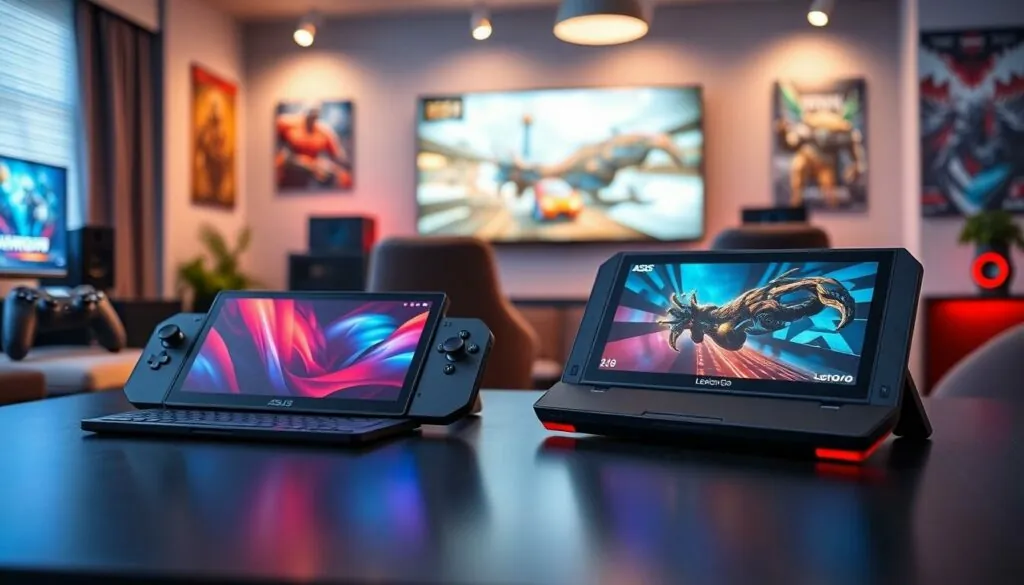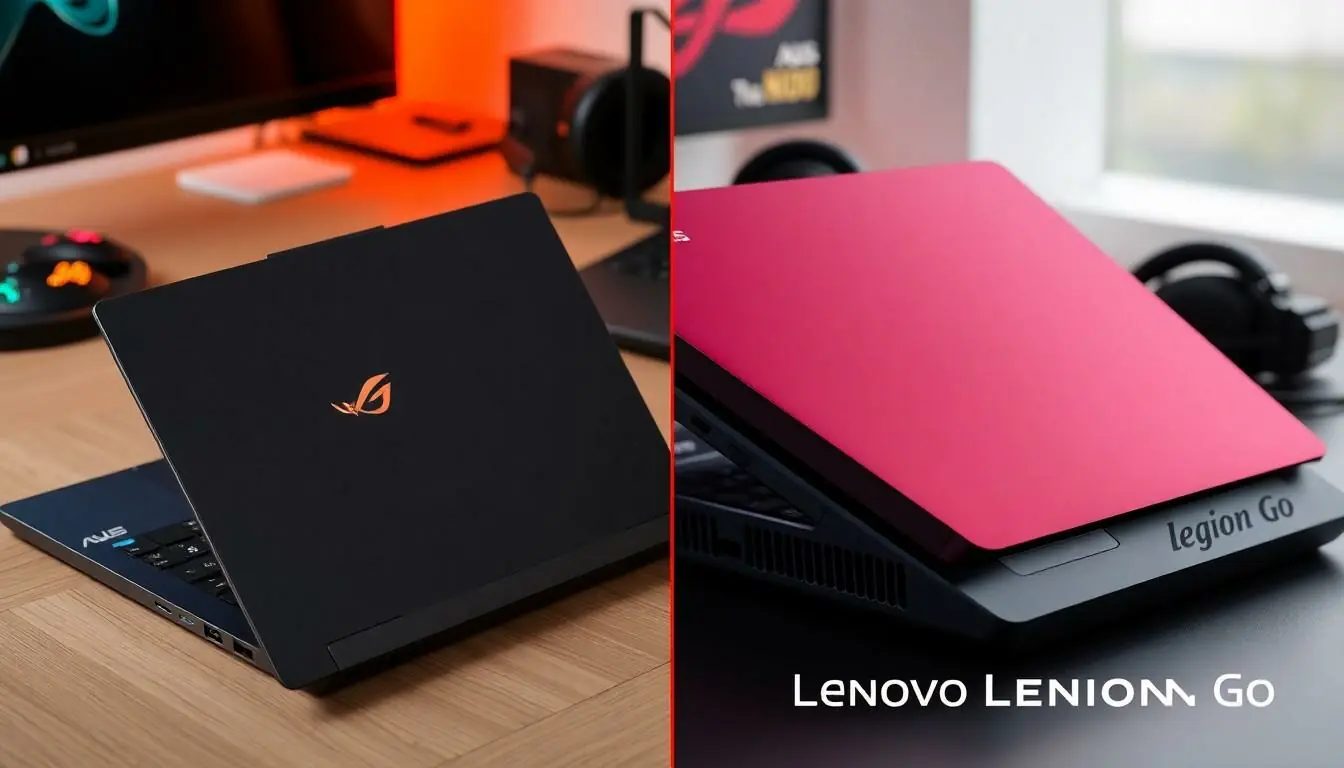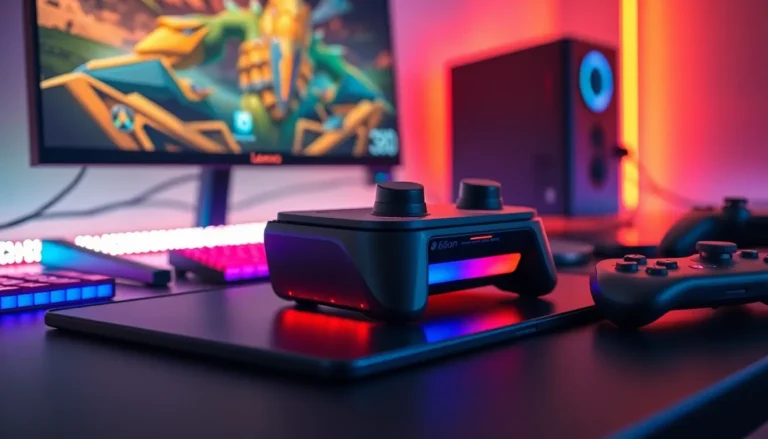In the ever-evolving world of handheld gaming, two contenders are battling for supremacy: the ASUS ROG Ally and the Lenovo Legion Go. Both devices promise to elevate the gaming experience, but which one truly deserves a spot in your gaming arsenal? Picture this: the ASUS ROG Ally, sleek and powerful, ready to take on the most demanding titles, while the Lenovo Legion Go boasts a unique design that’s as eye-catching as it is functional.
Table of Contents
ToggleOverview of Gaming Handhelds
Gaming handhelds combine portability and performance, appealing to gamers who enjoy gaming on the go. Devices like the ASUS ROG Ally offer powerful hardware in a compact design. This device supports high-end gaming experiences, allowing users to play demanding titles without being tethered to a stationary console.
Conversely, the Lenovo Legion Go emphasizes design and functionality. Its ergonomic layout caters to comfort during prolonged gameplay sessions, enhancing user experience. Battery life represents another crucial factor, with both devices providing sufficient power for hours of gaming without interruption.
Pricing structures also influence purchasing decisions among gamers, with the ASUS ROG Ally often positioned at a premium due to its superior specifications. The Lenovo Legion Go generally appeals to budget-conscious gamers while offering competitive features.
Connectivity options play a vital role in gaming handhelds. Both units support Wi-Fi and Bluetooth, ensuring seamless online play and compatibility with additional accessories. Display quality remains a key differentiator; the ASUS ROG Ally features a vibrant screen ideal for immersive gameplay, while the Legion Go provides excellent visuals with a focus on clarity.
In terms of software, ASUS typically integrates its own gaming-focused interface, enhancing user interaction with the device. Lenovo focuses on a more versatile approach, allowing users to access various gaming platforms easily. Each decision impacts user satisfaction and overall gameplay experience.
Performance benchmarks consistently show the ASUS ROG Ally excelling in intensive gaming scenarios. However, the Lenovo Legion Go maintains a commendable performance level, catering effectively to casual gamers and those seeking immersive gameplay experiences.
Design and Build Quality
Design and build quality significantly impact user experience and overall satisfaction with gaming devices. Both the ASUS ROG Ally and Lenovo Legion Go display unique features that cater to different preferences.
Size and Weight Comparison
Measurements reveal the ASUS ROG Ally’s compact form, making it easy to handle and transport. Weighing around 600 grams, it remains lightweight without compromising performance. The Lenovo Legion Go, however, is slightly larger and heavier—approximately 850 grams—yet its size promotes comfort during long gaming sessions. Gamers seeking portability might favor the ROG Ally, but those valuing a more substantial grip could prefer the Legion Go.
Material and Aesthetics
The ASUS ROG Ally showcases sleek lines and a modern aesthetic, appealing to gamers who appreciate refined designs. Materials used in its construction include high-quality plastics and metal accents, enhancing durability. In contrast, the Lenovo Legion Go adopts a more robust design with textured surfaces that boost grip. The bold color palette of the Legion Go gives it a distinctive look that stands out in any setting. Both devices maintain a premium feel, blending style with functionality effectively.
Performance Specifications
Performance specifications play a crucial role in comparing the ASUS ROG Ally and Lenovo Legion Go. Both devices aim to deliver an exceptional gaming experience.
Processor and Graphics
The ASUS ROG Ally features an AMD Ryzen Z1 Extreme processor coupled with an AMD RDNA 3 graphics card, ensuring superior graphics performance and speed. It excels in rendering high-resolution visuals smoothly, catering to demanding titles. In contrast, the Lenovo Legion Go utilizes an AMD Ryzen 7 7840U paired with integrated Radeon graphics. This combination offers competitive performance for most gaming scenarios, albeit not at the same high-end level as the ROG Ally. Players looking for intense gaming sessions may prefer the raw power of the ASUS device, while those focused on casual play might find the Lenovo’s capabilities sufficient.
RAM and Storage Options
Configurations vary significantly between the two handhelds. The ASUS ROG Ally supports up to 16 GB of LPDDR5 RAM, providing ample performance for multitasking and resource-heavy applications. Storage options include a fast 512 GB NVMe SSD, allowing quick loading times for games. The Lenovo Legion Go, on the other hand, offers similar RAM specifications but includes variations with 256 GB or 512 GB storage capacities. This flexibility accommodates gamers with varying needs, while the Legion Go’s microSD slot enhances extensibility, permitting additional storage for an extensive game library. Ultimately, both devices present solid options, aligning with the requirements of different gamer profiles.
Display Features
Display quality significantly impacts the gaming experience. The ASUS ROG Ally and the Lenovo Legion Go feature impressive screens that enhance gameplay.
Screen Size and Resolution
Both devices provide large screens that ensure engaging visuals. The ASUS ROG Ally sports a 7-inch 1920 x 1080 full HD display. In contrast, the Lenovo Legion Go offers a slightly larger 7.85-inch 2560 x 1600 resolution. Gamers seeking immersive details benefit from the higher resolution on the Legion Go, while the ROG Ally focuses on sharpness and clarity.
Refresh Rate and Color Accuracy
Refresh rates play a crucial role in delivering smooth visual performance. The ASUS ROG Ally boasts a 120 Hz refresh rate, ensuring fluid motion in fast-paced games. Lenovo Legion Go matches this with a 120 Hz refresh rate as well, offering comparable gameplay experiences. For color accuracy, the ROG Ally excels with vibrant colors, while the Legion Go emphasizes color depth, making both devices appealing for visually rich titles.
Battery Life and Charging
Battery performance significantly impacts the gaming experience on both the ASUS ROG Ally and the Lenovo Legion Go. Gamers prioritize battery life for prolonged enjoyment without frequent interruptions.
Usage Time on a Single Charge
ASUS ROG Ally delivers around 2 to 6 hours of gameplay on a single charge, depending on the game’s intensity and settings. In contrast, Lenovo Legion Go offers approximately 3 to 6 hours under similar conditions. This extended range on the Legion Go suits casual gamers, looking for longer sessions without the need for frequent recharges. Both devices support power-saving modes that help maximize usage time, letting users adapt their gaming sessions as needed.
Charging Speed and Options
Charging times vary between the two devices, with ASUS ROG Ally taking about 2 hours for a full charge using a USB-C power adapter. Lenovo Legion Go features a slightly faster charging capability, reaching a full charge in around 1.5 hours. Connectivity options include USB-C for both, accommodating fast charging needs easily. Lenovo’s dual charging options enhance versatility, allowing use while plugged in effectively. Users benefit from this flexibility, particularly during extended gaming marathons.
Software and User Experience
Both handheld gaming devices emphasize distinct software and user experiences, catering to various gamer requirements.
Operating System and Interface
The ASUS ROG Ally operates on Windows 11, providing gamers access to a broad range of PC games. A gaming-centric interface enhances user interaction and prioritizes performance settings. In contrast, the Lenovo Legion Go uses a customized version of Windows 11, focusing on versatility. This approach allows seamless switching among different gaming platforms. Gamers appreciate the intuitive design of both devices, facilitating smooth navigation and quick access to applications. Having access to a wide array of features gives both devices an edge in the gaming market.
Available Games and Compatibility
The ASUS ROG Ally excels in game compatibility with virtually all PC titles. It supports libraries across various platforms, allowing users to play demanding AAA games effortlessly. Lenovo Legion Go also supports a wide game selection, albeit with a slightly narrower focus on casual titles. Integration with platforms like Xbox Cloud Gaming enhances the Legion Go’s appeal, opening doors to streaming options. Compatibility with game libraries significantly influences the user experience for both devices. Gamers find they can dive into their favorite titles without worrying about limitations, making both options attractive for different gaming styles.
Pricing and Value
Pricing remains a crucial aspect when comparing the ASUS ROG Ally and the Lenovo Legion Go. Differences in cost directly influence buyer decisions and user experience.
Cost Comparison
ASUS ROG Ally carries a premium price tag due to its high-end specifications, typically retailing around $600. In contrast, Lenovo Legion Go targets budget-conscious gamers with a starting price of approximately $400. Budget variations stem from the differences in hardware capabilities, where the ROG Ally’s advanced features justify its lofty cost. Gamers should assess their financial limits alongside the desired gaming performance before making a decision.
Value for Gamers
Value assessment extends beyond initial pricing; it encompasses performance and usability. ASUS ROG Ally excels in game compatibility and graphics quality, catering to enthusiasts seeking intense gameplay. Despite the Lenovo Legion Go’s lower price point, it delivers solid performance, especially for casual gaming and streaming. Buyers often find that the investment in the ROG Ally translates to broader game accessibility and visual fidelity. The Legion Go, while more affordable, still presents a versatile option for gamers who prioritize ergonomic design and comfortable use over premium specs.
Conclusion
Choosing between the ASUS ROG Ally and the Lenovo Legion Go ultimately depends on individual gaming preferences and budget considerations. The ROG Ally stands out with its powerful specifications and extensive game compatibility, making it ideal for serious gamers seeking top-tier performance. On the other hand, the Legion Go offers a more budget-friendly option with a focus on comfort and casual gaming, appealing to those who value ergonomic design.
Both devices excel in their own right, providing unique features that cater to different gaming styles. Gamers should weigh their priorities, whether it’s performance and visuals or comfort and versatility, to find the handheld that best suits their needs.









